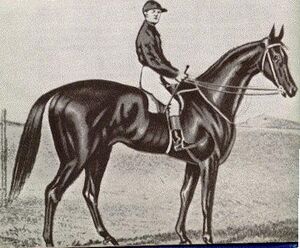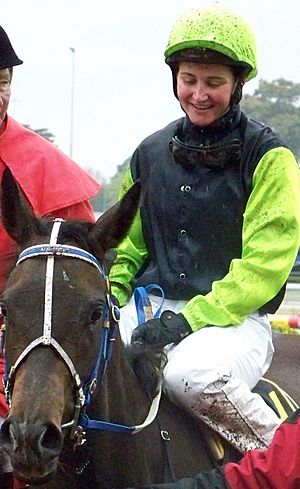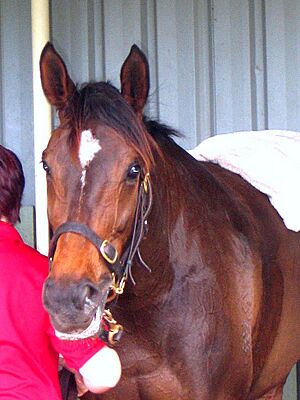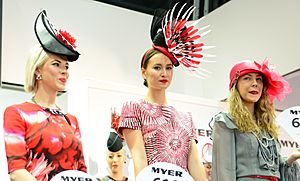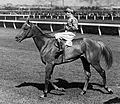Melbourne Cup facts for kids
| Group 1 race | |
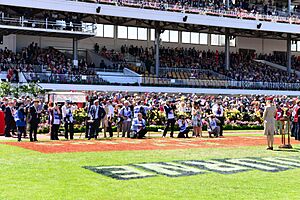
Melbourne Cup 2013
|
|
| Location | Flemington Racecourse Melbourne, Victoria, Australia |
|---|---|
| Inaugurated | 1861 (List of Melbourne Cup winners) |
| Race type | Thoroughbred – Flat racing |
| Sponsor | Lexus (2022) |
| Website | Melbourne Cup |
| Race information | |
| Distance | 3,200 metres (1 mile 1,740 yards) |
| Surface | Turf |
| Track | Left-handed |
| Qualification | Three-year-olds and up |
| Weight | Handicap |
| Purse | A$8,410,000 (2023) |
The Melbourne Cup is a famous horse race held every year in Melbourne, Australia. It takes place at the Flemington Racecourse. This exciting race is 3200 metres long. Horses that are three years old or older can compete. It's known as one of the richest horse races on grass in the world. The race always starts at 3:00 pm on the first Tuesday of November. Many people in Australia call it "the race that stops the nation."
The Melbourne Cup is a big part of Melbourne and Australian culture. It has been run every single year since 1861. The day of the race has been a public holiday in most of Victoria since 1876. The race distance was changed in 1972. It went from 2 miles to 3200 metres when Australia started using the metric system. The fastest time ever recorded for the race is 3:16.3. This record was set by Kingston Rule in 1990.
Contents
How Horses Qualify for the Race
The Melbourne Cup is a special type of race called a "quality handicap." This means that older horses usually carry more weight. Their weight is also adjusted based on how well they have raced before. The goal is to give every horse a fair chance to win. The race is for horses aged three years and older. It is run over 3200 metres at Flemington Racecourse.
The minimum weight a horse can carry is 50 kilograms. There isn't a maximum weight. However, the heaviest weight given to a horse must be at least 57 kilograms. The Victoria Racing Club decides these weights in early September.
Understanding Weight Penalties
After the weights are announced, horses might get extra weight. This happens if they win certain important races. These races include big handicap races worth over A$55,000. The VRC Handicapper decides how much extra weight they must carry.
Entry Fees for the Melbourne Cup
To enter the Melbourne Cup, horse owners usually sign up in early August. The first fee is $600 per horse. About 300 to 400 horses are nominated each year. But only 24 horses can race in the final event. Owners must pay more fees in the months leading up to the race. The final fee, paid the Saturday before the race, is $45,375. If a horse doesn't make it into the final 24, this last fee is given back.
How Horses are Selected for the Race
Race officials can choose to include or exclude any horse. To keep the race safe, only 24 horses are allowed. Horses are chosen based on several things. These include prize money they've won in the last two years. Their wins or high finishes in certain lead-up races also matter. The weight they are given in the handicap also plays a role.
Races That Guarantee a Spot
Winners of these races automatically get a spot in the Melbourne Cup:
- Lexus Stakes
- Cox Plate
- Caulfield Cup
- The Bart Cummings (since 2015)
- Andrew Ramsden Stakes (since 2019)
- The Ebor, York Festival (since 2019)
- The Roy Higgins Quality (since 2022)
The limit of 24 horses is for safety. In the past, many more horses raced. In 1890, there were 39 runners, which was the biggest field ever.
International Horse Preparation
Horses from other countries (except New Zealand) must go through quarantine. This means they stay in a special place in their home country for at least 14 days. This happens before they travel to Australia. The Werribee International Horse Centre is where international horses stay in Victoria. It's a special facility for horses competing in the Melbourne Spring Racing Carnival.
Prize Money and Trophies
How Much Money Can Be Won?
In 2023, the total prize money for the Melbourne Cup was A$8,410,000. The winning owner also gets a special 18-carat gold trophy. This trophy weighs 1.69 kilograms and is worth $600,000. The first 12 horses to finish the race receive prize money. The winner gets $4.4 million. Second place gets $1.1 million, and third place gets $550,000. Fourth place receives $350,000, and fifth place gets $230,000. Horses from sixth to twelfth place each earn $160,000. Most of the prize money (85%) goes to the owner. The trainer gets 10%, and the jockey gets 5%.
The 1985 Melbourne Cup was the first race in Australia to have $1 million in prize money.
The Famous Melbourne Cup Trophies
The winner of the very first Melbourne Cup in 1861 received a gold watch. The first actual trophy was given in 1865. It was a fancy silver bowl made in England. Today, it's owned by a famous Australian wine person, Wolf Blass. It is on display in South Australia. The oldest Melbourne Cup trophy that is still in its original form is from 1866. It was given to the owners of The Barb. You can see it at the National Museum of Australia.
For eight years, no trophy was given to the winner. Then, in 1876, Edward Fischer from Austria made the first Australian-made trophy. It was shaped like an ancient Etruscan vase with two handles. One side showed a horse race. The other side had "Melbourne Cup, 1876" and the winning horse's name.
The famous "loving cup" design with three handles was first used in 1919. This design is still used today. During World War II (1942-1944), winners received special war bonds instead of a trophy.
A new trophy is made every year for the winning owner. If two horses finish at the exact same time, a second cup is ready. The current trophy is made from 1.65 kilograms of 18-carat gold. The winning trainer and jockey also get smaller copies of the cup. The person who looks after the winning horse, called a "strapper," gets the Tommy Woodcock Trophy. This trophy is named after the strapper of the famous horse Phar Lap.
The Melbourne Cup Tour
Since 2003, the Melbourne Cup trophy goes on an annual tour. It visits communities all over Australia and New Zealand. This tour lets people see the famous trophy up close. It also shows how important the Melbourne Cup is to Australian and New Zealand culture. The tour visits schools, hospitals, and community events. It also travels to cities around the world to promote the race.
History of the Melbourne Cup
Early Years of the Race
Frederick Standish is given credit for coming up with the idea for the Melbourne Cup. He was a member of the Victorian Turf Club.
The first Melbourne Cup was held on Thursday, November 7, 1861. Seventeen horses competed for a prize of 710 gold coins and a gold watch. About 4,000 people watched the race. This was a good crowd, even though news of the explorers Burke and Wills dying had just reached Melbourne.
The first winner was a horse named Archer. He was a 16.3 hand tall bay stallion. Archer was ridden by John Cutts and trained by Etienne de Mestre. Archer was leased by de Mestre, meaning he was responsible for the horse.
The first race in 1861 was full of action. One horse ran off before the start. Three horses fell during the race, and two of them were badly hurt. Archer was not expected to win, but he beat the favourite horse, Mormon, by a long distance. This win caused a lot of excitement and rivalry between states. The very next day, Archer won another long-distance race, the Melbourne Town Plate.
There's a famous story that Archer walked over 800 kilometres to Flemington. But old newspapers show he actually traveled by steamboat from Sydney to Melbourne. He came with his trainer and other horses.
Archer won the Melbourne Cup again the next year, in 1862. He won 810 gold coins and another gold watch. About 7,000 people watched him win. He won by eight lengths, which was a record for over 100 years. Mormon finished second again. Winning the Melbourne Cup two years in a row was a rare achievement. It wasn't done again until Rain Lover won in 1968 and 1969.
In 1863, Archer was supposed to race again. But his trainer's entry form arrived late because of a public holiday. So, Archer was not allowed to race. Many owners pulled their horses out of the race to show support. Because of this, only 7 horses raced that year. This is the smallest number of starters in Cup history.
By 1865, Cup day was already a half-holiday in Melbourne. Public servants and bank workers finished early. Many businesses also closed at lunchtime. The Melbourne Cup was first held on a Tuesday in 1875. This was the first Tuesday of that month.
In 1876, a three-year-old female horse named Briseis won the Cup. She was owned and trained by James Wilson Snr.. Briseis then did something amazing. She won the VRC Derby, the Melbourne Cup, and the VRC Oaks all within six days! She was ridden by a very young jockey named Peter St Albans. He was officially 13, but actually 12 years old. He is the youngest person ever to win a Melbourne Cup. Briseis won easily in front of 75,000 people. People were so excited, they cheered and threw their hats in the air. Both Peter St Albans and Briseis became racing legends.
The 1876 Melbourne Cup had another big story. Two months before the race, a ship carrying 13 racehorses sank in a storm. Many of these horses were expected to do well in the Cup. This caused a lot of upset. But the outsider Briseis won, showing she was a truly great horse.
In 1877, trainer Etienne de Mestre won his fourth Melbourne Cup with Chester. In 1878, de Mestre won his fifth Cup with Calamia. This record stood for almost 100 years. Then, Bart Cummings, known as the best Australian horse trainer, won his fifth Cup in 1975. Bart Cummings went on to win 12 Melbourne Cups by 2008!
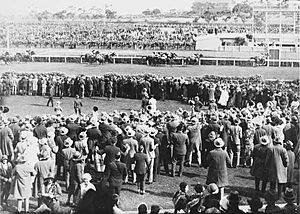
Phar Lap, one of the most famous horses ever, won the 1930 Melbourne Cup. He was the biggest favourite in the race's history. Before the race, there was an attempt to harm him. He had to be hidden away and only appeared an hour before the race. Phar Lap also raced in 1929 and 1931, but didn't win those years.
The first Aboriginal jockey to win the Melbourne Cup was Frank Reys in 1973. He rode Gala Supreme. His father was Filipino and his mother was half-Aboriginal.
Recent Melbourne Cup Highlights
In recent years, many horses trained overseas have entered the Cup. Some have won, like those trained by Dermot K. Weld from Ireland in 1993 and 2002. A horse from Japan also won in 2006. The first foreign-bred horse to win was Comedy King in 1910.
In 1938, Mrs. Allan McDonald trained the winner, Catalogue. She was a successful trainer in New Zealand. However, at that time, women were not officially allowed to be trainers in Australia. So, her husband's name was recorded as the winning trainer. In 2001, Sheila Laxon became the first woman to officially train a Melbourne Cup winner with Ethereal.
Maree Lyndon was the first female jockey to ride in the Melbourne Cup in 1987.
In 2004, Makybe Diva became the first female horse (mare) to win two Cups. She was also the first horse to win with different trainers.
The 2005 Melbourne Cup was watched by over 106,000 people. Makybe Diva made history by winning the race for a third time! Her trainer, Lee Freedman, said that no one alive would likely see that happen again.
In 2013, Damien Oliver won his third Melbourne Cup. He returned to racing after a ban.
The 2019 Melbourne Cup had less attention due to concerns about horse welfare. Some celebrities, like Taylor Swift, decided not to attend.
The Melbourne Cup Trophy
Since 2016, a company called ABC Bullion has made the Melbourne Cup trophy. The winning trophy is made from 1.65 kilograms of 18-carat gold. It is worth over $200,000. It takes over 250 hours to make each trophy by hand.
Important Moments in Melbourne Cup History
- 1861 – The first Melbourne Cup was held. Archer won. 17 horses raced.
- 1862 – Archer became the first horse to win the race twice.
- 1863 – Only seven horses raced. This was the smallest field ever.
- 1875 – The race was held on the first Tuesday in November for the first time.
- 1876 – Peter St Albans, the youngest jockey ever, won on Briseis. He was almost 13 years old.
- 1890 – The largest field ever, with 39 horses, raced. Carbine (horse) won, carrying a record heavy weight.
- 1915 – Mrs E.A. Widdis became the first woman owner to win with Patrobas.
- 1925 – The Melbourne Cup was broadcast on radio for the first time.
- 1930 – The legendary Phar Lap won his first Melbourne Cup. He was the biggest favourite in history.
- 1948 – The photo finish camera was used for the first time.
- 1960 – The race was shown live on TV in Sydney for the first time.
- 1962 – "Fashions on the Field" was first held.
- 1972 – The race distance changed to 3,200 metres from 2 miles.
- 1985 – The first Melbourne Cup with $1 million in prize money.
- 1987 – Maree Lyndon was the first female jockey to ride in the Cup.
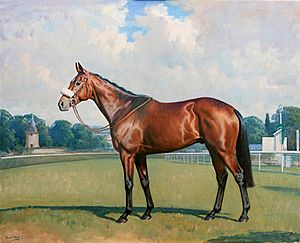
- 1993 – Vintage Crop from Ireland became the first horse trained in the Northern Hemisphere to win.
- 2001 – Sheila Laxon was the first woman trainer to officially win.
- 2003 – Clare Lindop was the first Australian female jockey to ride in the Cup.
- 2005 – Makybe Diva became the only horse to win the Melbourne Cup three times.
- 2008 – Bart Cummings won his 12th Melbourne Cup with Viewed.
- 2010 – The 150th anniversary of the race.
- 2011 – Dunaden won in the closest finish ever.
- 2013 – Gai Waterhouse became the first Australian female trainer to win with Fiorente.
- 2014 – Two horses had serious injuries after the race.
- 2015 – Michelle Payne became the first woman jockey to win the Cup on Prince of Penzance. Another horse, Red Cadeaux, was injured and couldn't be saved.
- 2018 – Cross Counter from Great Britain won. Another horse, The CliffsofMoher, was injured and couldn't be saved.
- 2021 – Verry Elleegant became the first horse to win from barrier 18.
A Public Holiday for the Race
Melbourne Cup day is a public holiday in Melbourne and some parts of Victoria. People often stop what they are doing to watch or listen to the race. Many people who don't live in Melbourne take time off work to celebrate. Some people think it should be a national holiday because so many people focus on the race.
The idea of a half-holiday for Cup Day started as early as 1865. It took some years for the holiday to be officially announced. In 1873, it was declared a bank and public service holiday.
Race Results and Records
Horses with the Most Wins
- 3 wins – Makybe Diva (2003, 2004, 2005)
- 2 wins – Think Big (1974, 1975)
- 2 wins – Rain Lover (1968, 1969)
- 2 wins – Peter Pan (1932, 1934)
- 2 wins – Archer (1861, 1862)
Jockeys with the Most Wins
- 4 wins – Bobbie Lewis
- 4 wins – Harry White
- 3 wins – Glen Boss
- 3 wins – Jim Johnson
- 3 wins – Kerrin McEvoy
- 3 wins – William H. McLachlan
- 3 wins – Darby Munro
- 3 wins – Damien Oliver
- 3 wins – Jack Purtell
Trainers with the Most Wins
- 12 wins – Bart Cummings
- 5 wins – Etienne de Mestre
- 5 wins – Lee Freedman
Owners with the Most Wins
- 7 wins – Lloyd Williams
- 4 wins – John Tait
- 4 wins – Etienne de Mestre
- 4 wins – Dato Tan Chin Nam
Other Interesting Records
- First woman winning jockey – Michelle Payne (2015)
- Fastest winning time – 3 minutes, 16.30 seconds by Kingston Rule (1990)
- Biggest winning gap – 8 lengths by Archer in 1862 and Rain Lover in 1968.
- Heaviest weight carried by winner – Carbine in 1890 with 66 kilograms.
- Lightest weight carried by winner – Banker in 1863 with 33 kilograms.
- Longest odds winners – Four horses have won at 100 to 1 odds.
- Shortest odds winner – Phar Lap at 8 to 11 odds in 1930.
- Most horses in a race – 39 horses in 1890.
- Fewest horses in a race – 7 horses in 1863.
- Oldest winner — 8 years old, Toryboy in 1865, Catalogue in 1938 & Twilight Payment in 2020.
Attending the Melbourne Cup
The Melbourne Cup is one of Australia's most popular events. Sometimes over 110,000 people attend. Many dress up in fancy race day clothes. Others wear fun and unique costumes. The record crowd was 122,736 people in 2003.
Since 2007, you need to buy tickets in advance to attend the Spring Carnival. More and more people travel to Flemington Racecourse each year. In 2016, there was a 7.8% increase in visitors from outside Victoria.
However, attendance at the Melbourne Cup has been going down recently. Every year since 2015 has seen fewer people attend. The 2019 Melbourne Cup had the smallest crowd in decades, with 81,408 people.
Fashion at the Races
"Fashions on the Field" is a big part of the day. There are great prizes for the best-dressed man and woman. People often wear elegant hats or fascinators. Race day fashion can sometimes get as much attention as the race itself! The miniskirt became famous worldwide when model Jean Shrimpton wore one at Derby Day in 1965.
Flowers, especially roses, are very important at Flemington. The racecourse has about 12,000 roses. Each major race day has an official flower. Melbourne Cup Day's official flower is the Yellow Rose.
In Melbourne, the race day has been a public holiday since 1877. Across Australia and New Zealand, many people watch the race on TV. They also place bets, either directly or in office "sweeps." In 2000, a betting company said that 80% of adult Australians placed a bet on the race that year.
The Melbourne Cup is often called "The race that stops a nation." But it's more accurate to say "The race that stops two nations." This is because many people in New Zealand also stop to watch the race.
Images for kids
Related Pages


